A Journey to the Past
In a region so defined by Lake Superior, it is no wonder that the North Shore is steeped in maritime history. From birchbark canoes to modern freighters and everything in between, traversing Lake Superior has been essential to the livelihoods of the many people who have called this place home. While every inch of the shoreline may be connected to maritime history in some way, here are a few places to stop to learn more about the region’s seafaring past.
Duluth’s Canal Park
When the State Lock at Sault Ste. Marie opened in 1855, Lake Superior opened up to ship traffic from the rest of the Great Lakes. As northern Minnesota was so rich in natural resources such as iron ore and timber, this made Lake Superior a prime highway to ship iron from Minnesota to steel mills in Detroit and along the East Coast.
The Duluth canal was dug in 1871 to allow ships to access the Duluth harbor. However, the creation of the canal cut off access to Park Point, meaning people had to access Park Point by ferry. To solve this problem, the precursor to the Aerial Lift Bridge–the Aerial Ferry Bridge–was completed in 1905, and brought cars to and from Park Point on a gondola. However, this design was not able to keep up with traffic, and the bridge was converted to the current lift bridge design in 1929-1930.
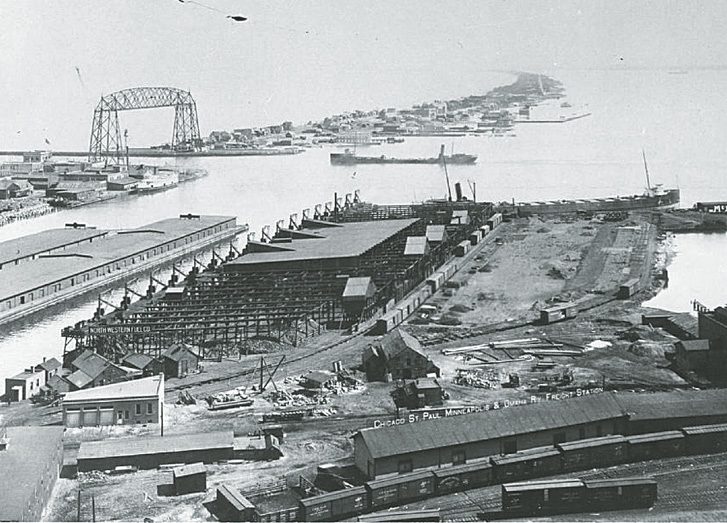
Visitors to Canal Park can visit the Lake Superior Maritime Visitor Center to learn all about the Twin Ports’ maritime history, and can watch ships entering and exiting the harbor under the lift bridge. Nearby, the William A. Irvin gives a glimpse into life on an ore boat, with tours taking guests aboard to see what being on a freighter is really like.
Across the highway, the St. Louis County Historical Museum has more information about the history of Duluth, including the USS Duluth display that has the 19-piece silver set from the ship.
Agate Bay, Two Harbors
At Agate Bay, visitors can catch a glimpse of Lake Superior’s past and present maritime activity. Agate Bay has been a shipping port since the 1880s, when the Duluth and Iron Range Railway needed to transport the iron ore mined inland to Lake Superior where it would be shipped out to become steel. The bay is still the site of operating loading docks.
Also in Agate Bay is the Edna G, a tugboat built in 1896 to help ore freighters in and out of Agate Bay. Called “the tug that helped build America,” the Edna G pulled ships and broke ice until her retirement in 1981. Now owned by the City of Two Harbors, the Edna G is on the National Register of Historic Places, and the nonprofit Friends of the Edna G is championing a restoration effort.
Crowning Agate Bay is the Two Harbors Lighthouse, Minnesota’s oldest operating lighthouse. After Agate Bay’s loading docks were built, the U.S. Lighthouse Service and the Vessel Owners Association asked that a lighthouse be built to help guide the ships entering and exiting the bay. Construction was completed in 1892, and the first lightkeepers moved in. The light was lit by oil until 1921, when it was changed to electricity. Eventually the U.S. Lighthouse Service merged with the U.S. Coast Guard, and in the late 1980s the light became automated by the Coast Guard station in Duluth.
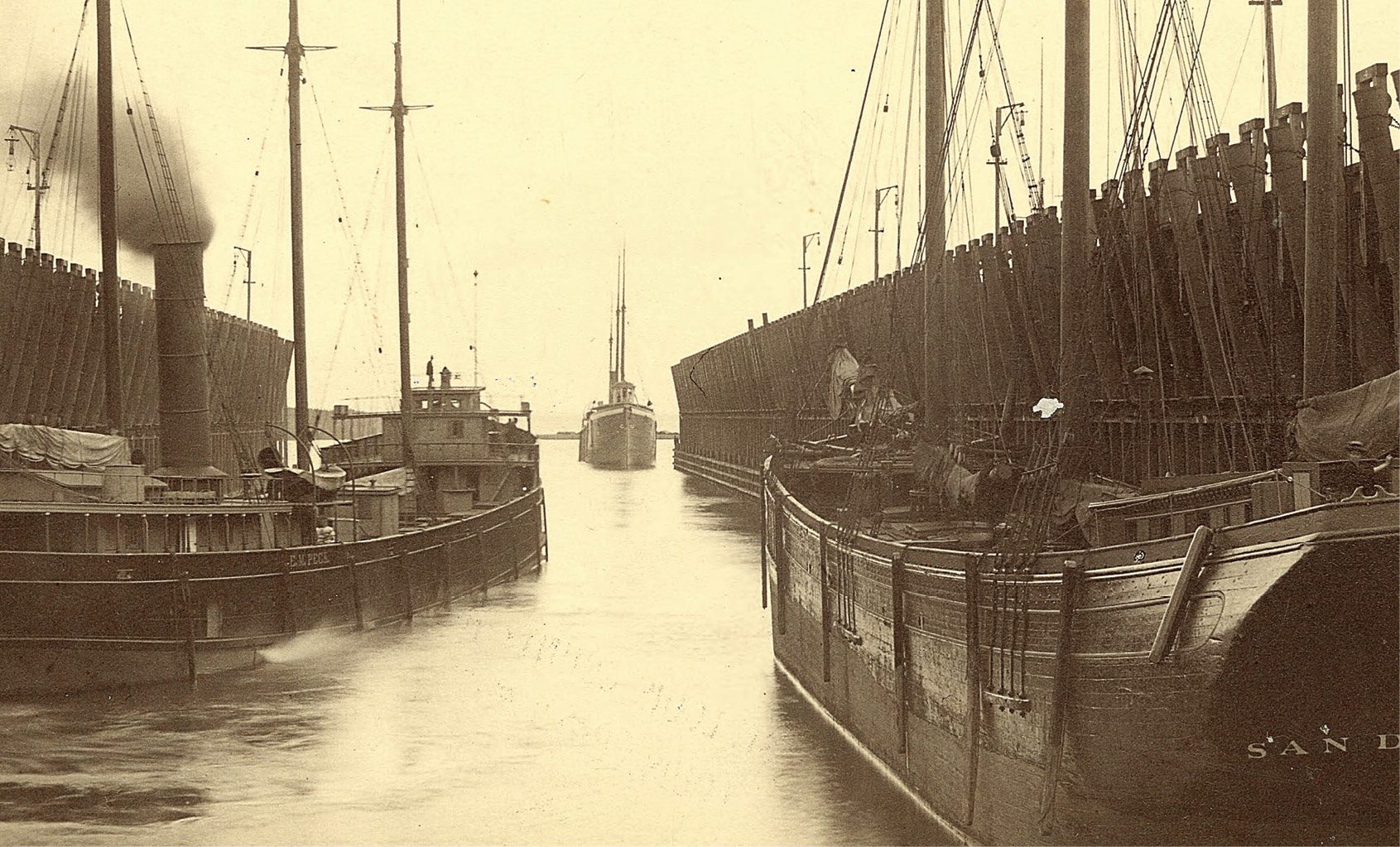
Today, the Lighthouse Museum is open to guests as a museum and as a bed and breakfast, though it is still considered an active navigational aid.
Split Rock Lighthouse
On November 28, 1905, a dangerous storm blew across Lake Superior, either damaging or completely destroying almost 30 ships across the lake, including four ships near where Split Rock Lighthouse currently stands. The need for a lighthouse was evident, and the owner of the four ships–the Pittsburgh Steamship Company–began to lobby for a light station to be built on what was then called Stony Point. The lobbying efforts paid off, and Split Rock Lighthouse was completed in 1910. Since its completion, no ships have sunk off of its shores.
The light station included the lighthouse itself, along with living quarters for the lightkeepers, a fog station, and storage buildings. Until 1924 there was no road to the lighthouse, meaning that the lightkeepers had to access the site by boat. (As did the builders constructing the lighthouse!) Once the road opened, Split Rock quickly became a tourist attraction, and it remains a focal point for visitors on the North Shore to this day.
Fenstad’s Resort
Fishing on the North Shore was a tough occupation, and not usually one that made a lot of money. Many of the fishing families of the early 20th century looked to other ways to supplement their income, including tourism. In fact, many of the North Shore’s original resorts were mom-and-pop operations run by commercial fishing families.
One such example is Fenstad’s Resort, located on Lake Superior in Little Marais. The Fenstad family settled in Little Marais 1883, and in 1936 Ben and Agnes Fenstad started the resort, building cabins to rent alongside their commercial fishing business. As time went on, the commercial fishing industry dwindled, but tourism didn’t. The ownership of the resort passed to the next generations, who built more cabins. Today, almost 90 years later, the resort is still operated by the Fenstad family, and guests of the resort can see the historic boathouse which still stands on the property. More information about the history of the resort can be found in the book The Lake is Your Life: The Fenstads at Little Marais by Art Fenstad, available at: shop.northernwilds.com.
Taconite Harbor
Just west of Schroeder on Highway 61 is Taconite Harbor, a loading dock and former town built in the mid-20th century by the Erie Mining Company. Taconite Harbor was built to transport taconite pellets mined at Hoyt Lakes. The pellets were brought by train to the Taconite Harbor loading dock, where they were loaded onto freighters to be shipped across the Great Lakes to make steel. To house the dockworkers, the neighborhood of Taconite Harbor was built, with prefabricated homes, a community center, and a fire hall lining Taconite Harbor’s two streets. The little community thrived until the 1980s when the Erie Mining Company scaled back operations and eventually told the remaining families that they would be selling the homes.
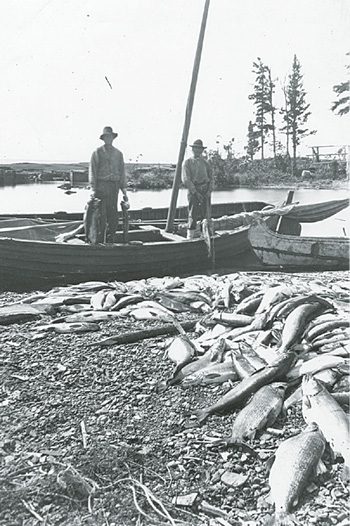
Today, Taconite Harbor is home to a boat launch and a small outdoor museum. As you drive in from Highway 61, keep an eye out for the former streets of the village. Visitors to the area can learn more about Schroeder’s history at the Cross River Heritage Center.
North Shore Commercial Fishing Museum
When Scandinavian immigrants moved to the North Shore, many of them turned to commercial fishing to make a living, selling their catches of Lake Superior fish to the A. Booth Packing Company. At the height of the Scandinavian fishing period in the early 20th century, over 400 commercial fishermen lived and fished along Lake Superior’s North Shore.
The North Shore’s commercial fishing history is chronicled at the North Shore Commercial Fishing Museum in Tofte. The museum is run by the Tofte Historical Society, and the building itself is a replica of a fish house that was located where Bluefin Bay Resort now stands. Visitors to the museum can learn all about the boats, materials, and techniques used in commercial fishing operations, as well as what life was like for the area’s local fishermen.
Cook County History Museum
Run by the Cook County Historical Society, the Cook County History Museum is housed in the old lightkeeper’s house, and includes an exhibit dedicated to the maritime history of Cook County.
Visitors to the museum will learn all about the history of Grand Marais and its close ties to the water. The Ojibwe name for Grand Marais is Gitchi-Bitobig, meaning “duplicate waters,” a name referring to the two natural bays; the Anishinaabe have lived and fished near Gitchi-Bitobig since the 1500s.
Before the 1920s there was no road connecting the North Shore, so boats were essential, both as a means of travel and for receiving cargo and mail. Since Grand Marais’s two bays formed a natural safe harbor, it has been a hub for all sorts of maritime activity. The harbor was dredged in 1879 to accommodate ships, and the first breakwaters were constructed in 1883 and 1901. Over the years, Grand Marais has been the site for all sorts of maritime activity, from barges carrying pulpwood from nearby lumber mills to steam ships such as the America and Dixon, to the herring skiffs built by Scandinavian fishermen.
In addition to visiting the museum, those wanting to learn more about Cook County’s history can participate in the Passport to the Past program, a joint endeavor between the county’s several historical societies and Grand Portage. Visit any museum or Heritage Center in Cook County to pick up a passport and start collecting stamps.
Grand Marais Harbor
A walk around the Grand Marais Harbor reveals many pieces of the area’s maritime history. In the Grand Marais Recreational Park, visitors can find the fish house of the Nee-Gee, a historic fishing tug built in the winter of 1936-37 by the Scott family. The Scott family were commercial fisherman and also built the historic Jim Scott Fish House, located on the North House Folk School campus. Fish houses such as the Scott Fish House used to be found all along the Grand Marais Harbor at the height of the commercial fishing era of the early to mid-20th century. To see what one of these fish houses looked like inside, visit the Cook County Historical Society’s fish house replica, located next to the Nee-Gee.
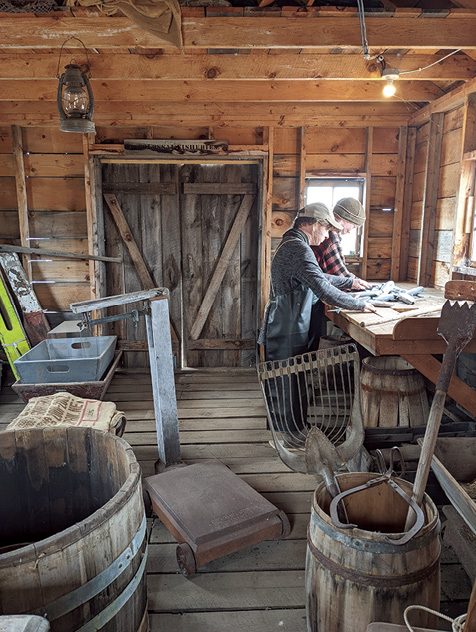
On the east side of the harbor is the Grand Marais Lighthouse and Coast Guard building. The North Superior Coast Guard Station was completed in 1929, and in addition to the current buildings, the station also included a lookout tower located on Artist Point, where Coast Guard staff watched for boats in need of help.
The Grand Marais Harbor has been home to a lighthouse since 1885. At the time of its building, the original lighthouse was the only light station between Duluth and Port Arthur. As you walk to the present-day lighthouse, keep an eye out for names carved in the rocks beside the breakwater. These carvings date back to the early 1900s, when passengers waited for steamers such as the America to arrive at the harbor.
To learn all about the Grand Marais Harbor’s history, the Cook County Historical Society offers Harbor History Walking Tours on Saturdays at 1 p.m., weather permitting.
Hovland Dock
Lake Superior’s shores used to be studded with commercial docks. One that remains is the Hovland dock, located on Hovland’s Chicago Bay. Built in 1905, the Hovland dock was a stop for cargo and passenger ships. Local dockworkers lived in nearby cabins and unloaded the cargo of ships en route between Duluth and Canada. (The bell at the base of the dock was used to announce incoming ships.) The dock was covered in concrete in 1925, and although parts of it have broken off, the majority of the concrete has withstood nearly a century of Lake Superior waves.
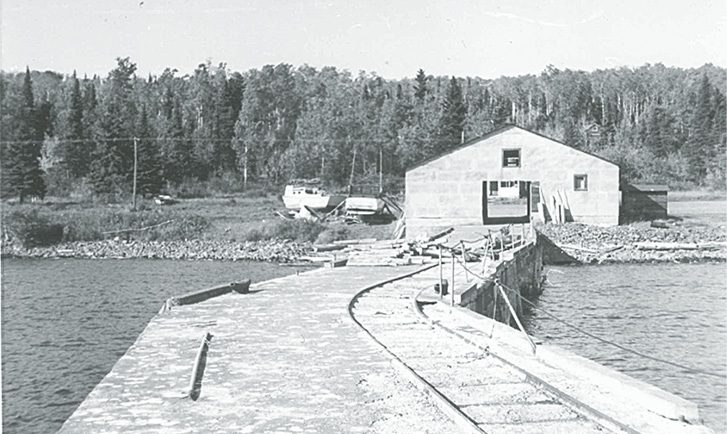
Grand Portage National Monument
At the Grand Portage National Monument, visitors can learn about the North Shore’s earliest human history and the region’s original boat: the birchbark canoe. Grand Portage derives its name from the 8.5-mile trail that links Lake Superior with the Pigeon River. Kitchi Onigaming, or “the great carrying place” has been used for thousands of years by the Indigenous people of the region. The Anishinaabe built canoes using birchbark, cedar planks, black spruce root, and spruce pitch–these canoes were lightweight and were used both for fishing on Lake Superior and navigating inland lakes and rivers.
When Europeans arrived in the region, Grand Portage became the hub for voyageurs from the North West Company, the largest fur trading company in the world at the time. Grand Portage was perfectly situated between Montreal, the home base of the North West Company, and the lands rich in furs to the northwest of Grand Portage. The Anishinaabe traded with the fur traders, who adapted the birchbark canoe to create the Montreal canoe. Montreal canoes were about 36 feet long and could carry up to three tons of cargo alongside a dozen paddlers. The fur traders used these canoes to traverse Lake Superior and reach Montreal with their furs before the winter freeze-up.
After the fur trade ended, the local economy turned to fishing, which many of the Anishinaabe along the North Shore were a part of. From 1834-1842, the American Fur Company started a large-scale commercial fishing operation on the North Shore, catching and shipping out Lake Superior whitefish, which were then sold throughout the country. They had several fishing camps along the North Shore, one of which was at Grand Portage.
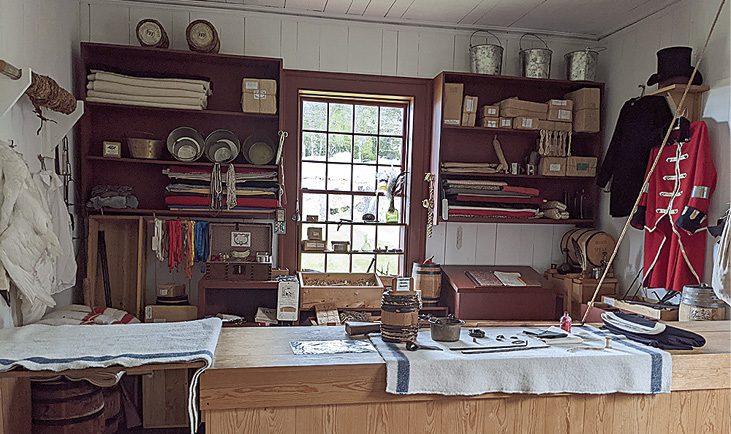
Today, the Grand Portage National Monument has the distinction of being co-managed between the Grand Portage Band and the National Park Service, the longest continually co-managed park in the country.
Isle Royale
Isle Royale is steeped in maritime history, from fishing to copper mining to modern-day navigation. Minong, the Ojibwe name for Isle Royale, has long been a location for fishing for the Anishinaabe, who used gill nets to harvest fish such as lake trout, herring and whitefish.
When Europeans began to move to the area, Isle Royale continued to be a hub for fishing. According to Tim Cochrane, former superintendent of the Grand Portage National Monument and author of several books on the history of Isle Royale, the early 1900s saw the peak of fishing by Scandinavian families on Isle Royale. By 1915, around 100 fishermen lived and fished on the island, heading out on Lake Superior two to a boat. Being a fisherman on Isle Royale was a tough life, with many supplementing their income by opening cabins to tourists or working in lumber camps over the winter. Fishing declined in the decades to follow, accelerated by the creation of Isle Royale National Park in the 1930s and the explosion of the sea lamprey population in the 1950s, which decimated the lake trout population.
Visitors to Isle Royale can learn more about the island’s folk fishing history at the Edisen Fishery, a restored fishery that includes a fish house, net house, cabins and historic boats. Isle Royale is also home to four lighthouses, most of which were constructed during the copper mining era in the mid to late 1800s. The restored Rock Harbor Lighthouse is located near the Edisen Fishery. The Passage Island Lighthouse to the northeast of Isle Royale is important because freighters traveling between Thunder Bay and Sault Ste. Marie still travel between Isle Royale and Passage Island today.

Thunder Bay
North of the border, Thunder Bay is an active port city, and there are several places where visitors can learn about its maritime history. The Thunder Bay Museum is run by the Thunder Bay Historical Museum Society, and the museum includes exhibits that showcase the early days of the city and its harbor.
The Alexander Henry is a Canadian Coast Guard ship, launched in 1958 and working until 1985 as an icebreaker and buoy tender. The ship was named after Alexander Henry, an early-19th century fur trader who led expeditions from what is today Thunder Bay.
After the ship’s retirement, it became a museum in Kingston, Ontario, before the Lakehead Transportation Museum Society of Thunder Bay purchased the ship in 2017 and returned it to Thunder Bay. Those boarding the Alexander Henry for a tour can see what it was like aboard this icebreaker.
The region is also home to several historic lighthouses, including the Welcome Island Lighthouse, the Porphyry Lighthouse, and the Shaganash (Island No. 10) Lighthouse.





